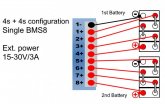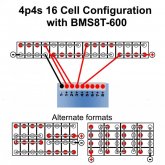The BMS can be powered by the pack itself IF the pack has the voltage. a 12V pack (4 LFP cells) isn't enough. Now that being said, the requirement is for 15 Volts capable of delivering 3A for their two standard electro-mechanical Contactors. If using Contactors which require less volts/amps like the TE/Kilovac EVE series that external voltage requirement can drop a bit. Depending on Configuration, the Chargery normally uses two relays and can be used in Common-Port or Separate-Port configurations. With Common-Port, it is possible to eliminate One Contactor by using an Optocoupler to receive the two relay signals and actuate only one contactor.
For more detailed info, refer to this post below. There is my DRAFT Chargery BMS8T Owner's Manual attached to that post. It may be worth your while to download that and review it, it should answer several of your questions. The Official Manuals should be out next week, there is lag between Json in China and myself and he's been "tweaking" a few things too.
Welcome to the forum. Regarding setup. I have to say, the 280AH cells ate 5.2Kg EACH / 11 Lbs ! These buggers are HEAVY and put 16 together, you will need help shifting it all around. 48VDC pack requires 16 LFP cells 88Kg / 194 Lbs. I highly recommend applying KISS rules to your build...

diysolarforum.com
You can ONLY MONITOR CELLS Which have a Balance Lead Attached to it. If Cells are paralleled you will only see the median of BOTH cells. This is what I mean by "ghosting cells".
Typical 4S + 4S w single BMS8T
this will allow you to monitor all cells, as there is one lead per cell.
View attachment 16802
Here we have 4 Cells in Parallel but 2 cells in parallel is similar.
This will only monitor cells with the leads attached. This shows an "average" of the paralleled cells.
In this instance below, you are reading the average of the 4 cells in parallel per lead.
View attachment 16803
! NOTE !
The BMS Harness is only 600mm long. If extending the wires, they should be of equal length and have soldered & heat-shrink wrapped connections, including the terminal rings on the ends. Such an installation is usually within one single cabinet with all cells close at hand to the harness.






